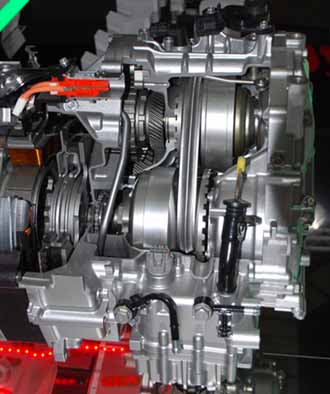

A short chat with the Honda Insight Chief Engineer
 At the official launch of the Honda Insight for Malaysia during the media day of the
Kuala Lumpur International Motor Show, I had the opportunity to have a short informal chat
with Tsuyoshi Ohkubo-san, who is the chief engineer involved in the Insight R&D.
At the official launch of the Honda Insight for Malaysia during the media day of the
Kuala Lumpur International Motor Show, I had the opportunity to have a short informal chat
with Tsuyoshi Ohkubo-san, who is the chief engineer involved in the Insight R&D.
Our conversation centered mainly on the technical points which someone who is familiar with Honda cars and considering a purchase of the Honda Insight, might be concerned about. The discussion was informal and therefore quite unstructured so this article is written to first explain the background and/or technical basis for the questions I asked which are in italics. Then I will explain what I understood from Okhubo-san's responses which will be in normal font.
Any factual errors in this article are all unintentional and would be mine, not Okhubo-san's.
The (infamous) 'Start-up Clutch'
 The Insight is available only with the CVT transmission. This transmission has
suffered some loss of credibility in certain countries in ASEAN, related to its supposed
unreliability. Almost all of the concerns about this
transmission centers around its use of a viscous coupling clutch pack to engage & disengage
drive to the front wheels. This has come to be called the 'Start-Up' clutch. So a key question
about the Insight's CVT transmssion is whether it uses a start-up clutch, or that like the 2nd
Generation JDM Fit, it uses the standard torque-converter instead.
The Insight is available only with the CVT transmission. This transmission has
suffered some loss of credibility in certain countries in ASEAN, related to its supposed
unreliability. Almost all of the concerns about this
transmission centers around its use of a viscous coupling clutch pack to engage & disengage
drive to the front wheels. This has come to be called the 'Start-Up' clutch. So a key question
about the Insight's CVT transmssion is whether it uses a start-up clutch, or that like the 2nd
Generation JDM Fit, it uses the standard torque-converter instead.
First of all, I want to highlight that it seems that the term 'start-up clutch' is not a term generally used by Honda R&D to describe the viscous coupling clutch pack. In fact when the Honda Malaysia senior manager translated my question using 'starto-uppu clutchu', Okhubo-san initially had difficulty understanding what I am referring to. It was only after more detailed explanation that he understood. So it seems that this 'start-up clutch' term is something that is used in the consumer side, with perhaps Honda dealers and service centers also using it. But to an R&D engineer, it is not a widely used term.
The Insight's CVT transmission is confirmed by Ohkubo-san as using a start-up clutch. Actually while studying the cutaway CVT, I had already saw the start-up clutch (photo on the left) but wanted an official confirmation. So what about reports of its supposed unreliability ? Ohkubo-san actually expressed surprise at this. From the perspective of R&D, the start-up clutch has been dependable and they never had reports of an actual mechanical failure. Further discussion led to an agreement that if the wrong transmission oil is used, e.g. ATF-Z1 instead of CVT-F, then the clutch plates can fail to engage properly. In this case, it ties to the necessity of proper maintenance of the gear-box. Besides the use of CVT-F, it was also highlighted that it is crucial to replace the oil once every 20,000km.
A key point to note is that this CVT is an improved version over those used in the 1st gen Fit, including the City (Fit-Aria in Japan). Many of the inprovements centers around smoother operations and improved reliability.
Weight penalty of the IMA system

Almost all discussions of the ownership of a hybrid have centered on the trade-off involved in using the battery-electric motor/alternator mated to a gasoline engine. Only the motor is actually mated to the engine while the battery is situated all the way at the rear of the car. But how much does the IMA motor added to the engine in terms of overall weight ?
Ohkubo-san does not know the exact figure. Nevertheless, the IMA motor is smaller and lighter than that used in the Honda Civic Hybrid. The battery pack itself is 28% smaller than the battery pack in the Honda Civic Hybrid. Overall the IMA system - electric motor, battery and ancilliaries have all been significantly decreased in size and weight from that used in the Civic Hybrid.
Battery Lifespan
Almost all discussions of the ownership of a hybrid have centered on the life-span of the battery. In this case, the battery pack used in the Insight is still the Nickel Metal-Hydride (NmH) though work is supposedly finalizing on the replacement Lithium Ion (LiO) alternative. As rechargeable batteries are already a familiar household item nowadays, thanks to handphones and various other home and personal appliances, people are familiar with issues of batteries failing due to the constant charging and discharging process. Another factor is the cost of replacement batteries, again from experience with handphones. Therefore one of the most widespread fear of hybrid ownership concerns the issue of how much it would cost to replace the battery pack when it eventually fails.
From the perspective of R&D, they have no knowledge of any premature failure of the battery pack due to defects. In fact, after 15 years from the debut of the 1st Generation Insight, Honda has yet to replace a battery pack under warantty due to failure.
About about the long-term reliability and especially charge duration of a battery pack that is constantly running in alternating charge and discharge conditions, Honda R&D does not believe it will have a detrimental effect. The memory effect doesn't affect NmH batteries. With regards to battery useful life-span, it is important to note that everything has a life-span. Even the regular petrol engine itself will need an overhaul after usually 200,000 km for e.g. So it is important to see the battery pack from this angle, i.e. if used for a very long period, like everything else in the car, it will have to be replaced. But Honda R&D sees this as 15 years and beyond.
TOVA opinion. Honestly this figure (15 years) seems a bit too good to be true. Perhaps a life-span in terms of mileage might have been a better figure to request from Okhuba-san as obviously life-span expectancy depends more heavily on degree of usage. It seems that R&D is saying the battery life-span do in fact exceed the overhaul/rebuild interval of the engine. So by the time the engine would benefit from an overhaul, say around 250,000 km, the message seems to be that the IMA battery pack should still be operating at a very useful performance. This is of course when the car is used under normal conditions. Honda Malaysia's own local pro-active action to handle this concern is two-fold. Firstly, while the car continues to have a 3-years warantty, the battery-pack itself is warantted for 5 years or 150,000km whichever comes first. Secondly, should any owner actually needs to purchase a new battery, Honda Malaysia is prepared to offer them at a significant discount. For actual prices of a replacement battery pack, contact the nearest Honda dealer for a quote.
What about feedback from current Honda Hybrid owners ?. In today's car ownership environment, it has become the trend for enthusiats owners to share their ownership experience on the internet, usually through forums, and usually when it is bad. So something as controversial as IMA battery lifespan or failure would surely become widely circulated amongst the numerous car and also hybrid related forum. Personally I have not come across any such information from Honda hybrid owners in Malaysia. For the rest of the world, I have come across a few claims, from Civic Hybrid owners about supposedly pre-mature failure of their battery pack. However, none of such threads were properly concluded. They usually die a premature death, with the original starter of the thread suddenly going quiet without any update. I have not yet come across any threads about Honda IMA battery failure that has been proved conclusively, though I have to be fair and highlight it does not mean that there are none.
Rear Headroom
A widely known issue with the Insight is the rear headroom. This I was quick to check out by climbing into the back seat myself. As I am a 6-footer, I can confirm that someone around my height would have his/her head really flush against the ceiling of the cabin when sitting straight up. A degree of slouching on the rear seats would be needed if one wants to avoid the head banging against the ceiling on bumpy rides.
This is something Honda R&D acknowledges. This lack of headroom was looked at during design and was accepted as one of the compromises of the Insight body design, in return for the aerodynamic shape which R&D found is crucial for the Insight's fuel economy. As a trivia, Honda categorizes the Insight as a 'hatchback', not a 4door coupe.

Bad showing in the U.S.
As the time arrives for the official unvealing of the Insight, I posted one last question to Okhubo-san, this one perhaps a bit more 'sensitive' than the others. This has to do with the Insight in the U.S. and why it has not been as successful in that country whereas it has been selling very well in Japan and apparently reasonably well in Europe as well.
Again this is something R&D is aware of and which Honda has looked at closely. One of the main reasons for the Insight's lack of acceptance in the U.S. is definitely the rather high price. Despite all the arguements about options and so forth, the fact remains that it is priced at a level that is comparable to regular models like the Civic 1.8. Honda knows that a lot of hybrid buyers does justification of any price premium by working off calculated savings in fuel/petrol consumption over the expected (ownership) life-span of the car. This is something Honda does not dispute as being a very valid way of evaluating ownership of the Insight. But even at the high price levels of petrol/fuel today, this kind of justification very seldom works out. I.e. if we try to offset the higher cost of a hybrid by calculating how much we can save in petrol/fuel costs over a period of say, five years, we will almost never get it.
Tied to this is also the fact that there are cases where the Insight did not deliver the excellent fuel economy that is expected of a hybrid car. This has a lot to do with the usage of the car - how much highway travel for e.g., and other factors. Eventhough a hybrid, the fact remains that like a regular car, a concious effort and change in driving style, and favourable conditions are still needed before the Insight can deliver the excellent mileage it is capable of.
One interesting trivia is that Honda's measurement of fuel consumption are always done with the air-conditioning (or heater) off. I.e. the 10.15 mode fuel consumption rating of 30km/l for the JDM Insight is rated with the air-conditioning and heater off. In usage conditions where the air-conditioning or heater will see extended use, the Insight and all other Honda cars will not be able to deliver their 10.15 mode rated mileage.
March 2011
© Temple of VTEC Asia